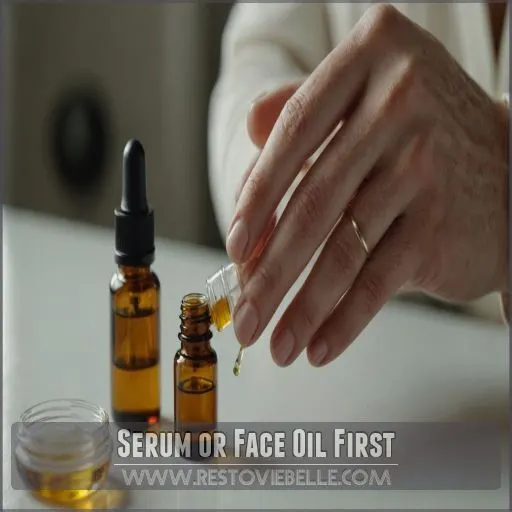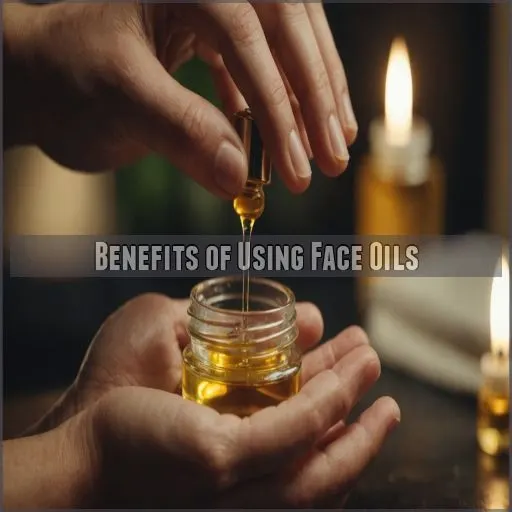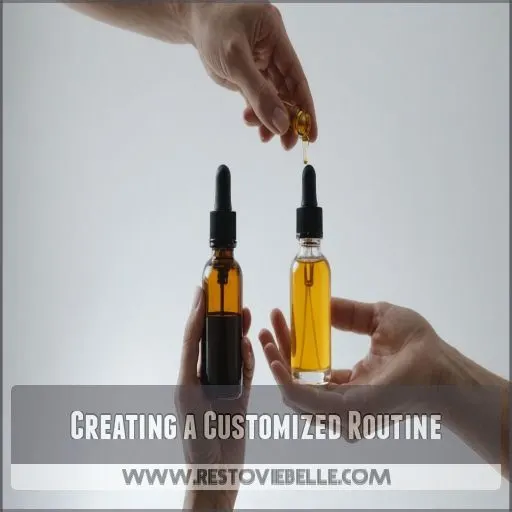This site is supported by our readers. We may earn a commission, at no cost to you, if you purchase through links.

Think of it like a sandwich: the serum is your multi-vitamin-packed layer, penetrating deeply to tackle skin concerns like dullness or aging. Once that’s absorbed, face oil swoops in like a superhero cape, sealing in all that goodness and boosting your skin’s moisture barrier.
So, serum first, face oil second. It’s a dynamic duo for every skin type, from oily to dry, like the gentle cleansers that are pH-balanced recommended for sensitive skin
.
Now, if you’re intrigued by how this skincare combo can transform your routine, stick around for more tips that might surprise you.
Table Of Contents
- Key Takeaways
- Serum or Face Oil First
- Benefits of Using Face Oils
- Benefits of Using Serums
- How to Apply Face Oils and Serums
- Using Face Oil and Serum Together
- Choosing Between Face Oils and Serums
- Can You Use Face Oil Without Serum
- Creating a Customized Routine
- Frequently Asked Questions (FAQs)
- What is the difference between a serum and a face oil?
- What is the best oil to take for healthy skin?
- Should you use a face oil or a serum?
- Does face oil & serum work together?
- What goes first, face oil or serum?
- Is face oil or serum better?
- Can I use oil as serum for face?
- When to apply face serum?
- How do face oils affect oily skin?
- Can face oils and serums cause breakouts?
- Are there serums for sensitive skin?
- Do face serums need to be refrigerated?
- How long does each product take to absorb?
- Conclusion
Key Takeaways
- You’ll want to apply your face serum before your face oil – think of it like layering your clothes, with the serum as your comfy t-shirt and the oil as your cozy jacket.
- Your skin type is the star of the show here. If you have oily skin, go light on the oil. If you have dry skin, slather on that face oil like it’s going out of style.
- Don’t be afraid to mix and match. Using both serum and face oil can give your skin a one-two punch of hydration and targeted treatment – it’s like being your own skincare mixologist.
- Remember, patience is a virtue. Let each product absorb before moving on to the next – your skin isn’t a racetrack, it’s more like a spa day.
Serum or Face Oil First
You’re standing in front of your bathroom mirror, juggling a serum in one hand and a face oil in the other, wondering which goes first.
The answer is simple: apply your serum before the face oil.
To let those active ingredients work their magic while the oil seals in hydration.
Understanding Skin Oil and Skin Water
Understanding skin oil and water is key to a balanced routine.
Recognize:
- Skin barrier: Shields against moisture loss.
- Oil balance: Important for smooth, hydrated skin.
- Water retention: Prevents dehydration.
- Serum vs. face oil: Serums, with ingredients like hyaluronic acid and vitamin C, boost hydration levels; face oils lock it in.
This harmony between serums and face oils, much like the relationship between essence and serum, promotes healthy, radiant skin.
The Role of Serums and Face Oils
Think of a face serum as your skin’s superhero, packed with active ingredients targeting specific concerns like dullness or aging.
These lightweight formulas penetrate quickly.
Face oils, thicker and nutrient-rich, act more like a cozy blanket, sealing everything in and strengthening your skin’s barrier.
Both can enhance your skincare routine, with serums typically applied before oils, which can target specific concerns .
Skin Type and Product Order
Now that you know the roles of serums and face oils, let’s talk about skin type and product order.
Consider oily skin’s need for a lightweight serum first, while dry skin benefits from layering a face oil after serum to lock in moisture.
For sensitive skin:
- Use hydrating serums.
- Choose calming oils.
- Adjust based on your skin routine.
Day Vs. Nighttime Routine
Your daytime routine should start with a face serum to target specific skin concerns, followed by a moisturizer with SPF to protect against environmental aggressors.
At night, apply your face oil after serum to seal in all the nourishing ingredients and prevent water loss. This simple order helps your skin get the care it needs around the clock.
Benefits of Using Face Oils
Face oils are like cozy blankets for your skin, delivering essential fatty acids and lipids to keep it healthy and glowing.
They help prevent water loss, protect you from environmental stress.
They also soothe dry skin or pesky conditions like eczema.
Delivering Fatty Acids and Lipids
Face oils, with their rich texture, deliver a wealth of fatty acids and lipids to your skin. They enhance the skin barrier function and lipid replenishment, giving you that radiant glow.
Unlike serums, oils like argan and evening primrose work directly with your skin’s natural oil production, offering important linoleic acid and essential fatty acids.
Some carrier oils, such as coconut MCT oil, even help to boost collagen and improve skin texture.
Additionally, they provide intense hydration and prevent dryness, making them an excellent addition to any skincare routine.
Preventing Transepidermal Water Loss
To prevent transepidermal water loss, consider using a face oil after your serum.
Face oils create a protective layer that locks in moisture, supporting the skin barrier function and reducing water evaporation.
This is particularly beneficial for dry skin solutions.
By sealing in hydration from your serum, like one with hyaluronic acid, it helps your skin stay plump and healthy.
Protecting Skin From Environmental Factors
While guarding against water loss, face oils also shield your skin from environmental foes.
With antioxidant benefits, these oils form a barrier that fights pollution, prevents sun damage, and reduces UV radiation exposure.
By neutralizing free radical damage, they help maintain collagen synthesis and balance sebum levels, keeping your skin resilient against oxidative stress and environmental toxins.
Soothing Dry Skin and Skin Conditions
Achieve smooth, hydrated skin by using natural oils like tea tree oil and others rich in essential lipids.
These oils help repair the skin barrier, providing dry skin remedies and soothing relief for eczema and rosacea.
With regular use, you’ll enjoy long-lasting moisture and protection against skin conditions, empowering your skin with the care it deserves with the care it deserves .
Benefits of Using Serums
You might think of serums as tiny superheroes for your skin, packed with high concentrations of active ingredients ready to tackle everything from dullness to pesky breakouts.
With their lightweight, quickly absorbed formula, they’re perfect for targeting specific skin issues while leaving your face feeling refreshed and hydrated, making them a great tool for addressing dullness and other skin concerns.
High Concentrations of Active Ingredients
Face serums pack a powerful punch, delivering high concentrations of active ingredients like glycolic acid or salicylic acid to target specific skin concerns.
Whether you’re battling blemishes, dullness, or signs of aging, a well-chosen serum can work wonders.
Just be sure to apply it before heavier moisturizers to maximize its benefits.
Hydrating Properties of Serums
Serums offer remarkable hydrating properties, especially for dehydrated skin.
By using water-based serums enriched with hyaluronic acid, you can attract and retain moisture, laying a solid foundation for a youthful glow.
This serum for dry skin boosts hydration but also aids in skin brightening, making it an essential component in combating signs of aging and dullness, providing a youthful glow.
Targeting Specific Skin Problems
After hydrating, tackling specific skin problems becomes key. Serums excel here, offering targeted care for various skin concerns. Whether it’s acne-prone skin or hyperpigmentation, a serum can cater to your needs.
- Reduce wrinkles
- Brighten dark circles
- Balance oily skin
- Aid skin resurfacing
- Calm acne breakouts
Choose wisely for your unique skin story.
Soothing Sensitive Skin and Redness
You’ve tackled targeting specific skin problems, and now you’re ready to soothe sensitive skin and redness. A face serum is your best friend here.
Packed with calming ingredients and anti-inflammatory properties, it supports your skin barrier while reducing redness triggers. Plus, with vitamin C for skin exfoliation, you’ll see a clearer, calmer complexion.
| Benefit | Emotional Impact |
|---|---|
| Calming Ingredients | Relaxed, Comforted |
| Redness Reduction | Confidence Boost |
| Skin Barrier Support | Protected, Safe |
How to Apply Face Oils and Serums
You’ve got your serums and oils lined up, but which goes on first? Don’t worry—just remember, serums sneak in before oils like your favorite snack before the main meal.
Layering Face Oil Over Serum
To make the most of your skincare, apply face oil over your serum.
This allows products like oil-based serums to deeply penetrate and hydrate, locking in their benefits.
Whether you’re tackling a morning routine or a nighttime beauty routine, remember the thicker, richer consistency of oils makes them an ideal final touch, ideal for safeguarding against chemical exfoliants and UV rays.
The Role of Moisturizer in the Routine
Moisturizer acts as the key top layer in your skincare sandwich, sealing in the benefits of serums and face oils.
Choose a moisturizer type that matches your skin’s needs—lightweight gels for oily skin or richer creams for dry skin.
Don’t skip it unless you’re experimenting; its benefits include hydration and protection, ensuring your skin stays smooth and radiant.
Protecting Skin From Environmental Pollutants
Protecting your skin from environmental pollutants is essential.
Look for antioxidant-rich oils and serums that contain ceramides or hyaluronic acid to strengthen your skin’s barrier and prevent damage. Vitamin E oil, with its moisturizing and hydrating benefits, can also be an effective addition to your skin care routine, providing antioxidant benefits from vitamin E oil. Additionally, its ability to combat free radicals can help safeguard your skin from oxidative stress.
Pair these with a mineral sunscreen to block UV rays and pollutants. Your skin will stay healthy, vibrant, and resilient against the daily onslaught of environmental toxins.
Using Face Oil and Serum Together
Pairing face oil with serum is like giving your skin a revitalizing drink followed by a cozy blanket—ideal for boosting hydration and skin health.
By working together, they strengthen your skin’s natural barrier, so it’s ready to face whatever the day throws at it with a stronger natural barrier.
Boosting Hydration and Skin Health
You’ve mastered applying oils and serums, so now let’s boost hydration and skin health.
Mixing face oil and serum in your skincare routine helps lock in moisture and enhances your glow.
Use serum for hydration tips and nutrient-rich oil to maintain a healthy skin moisture barrier, similar to how daily hydration helps maintain hair moisture balance preserving natural oils
.
Together, they can provide a powerful combo for radiant skin .
Strengthening the Skin’s Natural Barrier
Using both face oil and serum can strengthen your skin’s natural barrier. This combination improves skin barrier function, aids in barrier repair, and provides ceramides for added protection.
Keep these tips in mind:
- Apply serum first, then face oil.
- Choose products rich in ceramides.
- Follow a healthy diet for skin support.
- Consider lifestyle factors like stress and sleep.
Choosing Between Face Oils and Serums
You might wonder whether to pick a face oil or serum for your skincare routine, but don’t stress—it’s all about knowing your skin’s needs, especially when using a gentle Korean exfoliator
.
Think of it like choosing between ice cream and cake; sometimes you want one, sometimes the other, and sometimes a little of both is perfect!
Considering Skin Type and Needs
Choosing between face oils and serums depends on your skin type and needs.
For oily skin, opt for lightweight serums to balance excess oil. Dry skin benefits from rich face oils to boost hydration.
Sensitive skin requires gentle ingredients, while acne-prone skin might use both for targeted care, often found in the best foam cleansers
. Mature skin benefits from products addressing wrinkles and hydration.
Addressing Specific Skin Concerns
Address specific skin concerns by picking between face oils and serums.
Face serums tackle acne, hyperpigmentation, and wrinkles with targeted ingredients like retinoids and niacinamide (Source). On the flip side, face oils moisturize and soothe dryness or sensitivity with nourishing fatty acids.
- Acne treatment
- Hyperpigmentation reduction
- Anti-aging properties
- Soothing dry or sensitive skin
Consider these when tailoring your skincare approach.
Evaluating Product Ingredients and Formulations
When choosing between a face serum or face oil, consider the product’s ingredient list and formulation.
Serums typically have a lightweight, water-based texture that quickly absorbs, delivering concentrated active ingredients like vitamin C or retinol.
Face oils, on the other hand, are richer and more emollient, providing deep hydration and nourishment.
Evaluate your skin type and needs to determine which option is best for you, based on your specific skin concerns and desired benefits of using a face serum or face oil.
Combining Face Oils and Serums
You’re choosing between face oils and serums, thinking about the ingredients and formulations. Embrace the combo benefits of oil layering for hydrated, glowing skin. It’s not an either/or decision. Mix and match based on your skin type and goals.
- Serums penetrate deeply to target concerns.
- Face oils lock in moisture.
- Combo enhances your skincare routine.
Can You Use Face Oil Without Serum
You might wonder if you can use face oil without a serum, especially when you’re keen to simplify your skincare routine.
Don’t worry, your skin won’t throw a fit if you skip the serum, but understanding your skin type can help you make the best choice for a glowing complexion.
Benefits of Using Face Oil Alone
Using face oil alone can work wonders for your skin barrier.
It provides dry skin relief, locking in moisture and supporting a natural glow.
Face oils can also offer anti-aging effects and even help with oily hair treatment by balancing excess sebum production
.
Embrace the simplicity: sometimes less is more when caring for your skin’s health.
Drawbacks of Not Using Serum
While using face oil alone can boost hydration, skipping serums might mean missing out on active ingredients that target specific skin concerns.
Such concerns include deeply moisturizing and providing antioxidant protection against free radical damage found in natural ingredients like coconut oil coconut oil benefits.
Serums penetrate deeply, helping to improve skin barrier health and overall product efficacy.
So, opting for both could enhance your skincare routine’s results, tackling those skin issues more effectively than oil alone.
Skin Types Suitable for Face Oil Only
For various skin types—dry, oily, sensitive, acne-prone, and mature—face oils might just be your perfect match.
Dry skin craves that extra moisture, while oily skin surprisingly finds balance.
Sensitive skin will appreciate the calming touch without irritation, and mature skin benefits from the nourishing properties.
So, your skin could thrive with just oils, skipping serum.
Creating a Customized Routine
When creating your customized skincare routine, start by figuring out your skin type and what it needs.
Whether you’re dealing with dry patches or the occasional breakout, remember that your routine might need a few tweaks before it’s just right.
So don’t be afraid to adjust it as needed, just like a good pizza.
Evaluating Skin Type and Concerns
First, observe your skin throughout the day to determine your type.
Oily skin will appear shiny, while dry skin feels tight.
Combination skin has an oily T-zone and drier cheeks.
Knowing your unique needs helps you choose the right face oils and serums to address concerns like acne, aging, or sensitivity.
Selecting Face Oils and Serums
Recognizing your skin type sets the stage for selecting face oils and serums. Choose based on whether your needs are oil-based or water-based.
- Identify ingredients to avoid, like allergens.
- Consider budget-friendly options without sacrificing quality.
- Opt for correct layering tips, ensuring products complement your routine.
Keep it simple and effective!
Adjusting the Routine as Needed
You’ve chosen your face oils and serums, but sometimes your skin needs a little mix-up. Think of seasonal changes, skin sensitivity, or introducing new products.
Keep an eye on product expiry to make sure they’re still effective. Check your routine goals often and adjust accordingly.
Here’s a handy table:
| Factor | Adjustment |
|---|---|
| Seasonal Changes | Lighter products |
| Skin Sensitivity | Hypoallergenic |
| Product Expiry | Replace often |
| New Products | Introduce slowly |
| Routine Goals | Evaluate monthly |
Frequently Asked Questions (FAQs)
What is the difference between a serum and a face oil?
Serums are lightweight, water-based formulas that target specific skin concerns like wrinkles and uneven tone with active ingredients.
Face oils, being richer and oil-based, provide deep hydration and nutrients, enhancing your skin’s natural barrier.
What is the best oil to take for healthy skin?
Imagine having skin that radiates health and vibrancy.
The secret? Jojoba oil. Packed with vitamins and antioxidants, it absorbs easily, providing moisture without clogging pores or causing breakouts.
Isn’t that just what your skin craves?
Should you use a face oil or a serum?
Consider your skin’s needs: A serum targets specific concerns like wrinkles or dark spots with active ingredients, applied before moisturizer.
A face oil locks in moisture and nourishes the skin, ideal for dryness or irritation.
Does face oil & serum work together?
Face oil and serum can work together by layering them to maximize skincare benefits.
Apply serum first to deliver targeted active ingredients, then lock in moisture with face oil.
This duo creates a powerful, balanced skincare routine .
What goes first, face oil or serum?
Apply your face serum first, then follow with face oil.
Serums, being lighter and packed with actives, absorb quickly.
The oil acts like a seal, locking in moisture and enhancing your skincare routine’s effectiveness.
Is face oil or serum better?
Choosing between face oil and serum is like picking between coffee and tea—they serve different purposes.
Serums target specific concerns with active ingredients, while face oils provide moisture.
Use them together for best results.
Can I use oil as serum for face?
You can use face oil as a serum, but they serve different purposes.
Oils hydrate and protect the skin barrier, while serums target specific concerns with active ingredients.
Combining both can benefit your skincare routine.
When to apply face serum?
Wondering if it’s necessary to use face serum twice daily?
It sure enhances absorption before moisturizer.
Apply after cleansing and toning but before moisturizing, morning and night, for smooth, radiant skin without feeling greasy.
How do face oils affect oily skin?
Face oils can actually benefit oily skin by replenishing moisture and balancing oil production, which is often a challenge for those dealing with large pores and acne solutions for large pores
.
Look for non-comedogenic oils like Cannabis sativa seed oil to avoid clogging pores.
Proper use is key to managing oily skin with face oils.
Can face oils and serums cause breakouts?
Selecting suitable face oils and serums helps prevent breakouts.
Lightweight, non-comedogenic oils like jojoba and squalane can balance oily skin, while avoiding heavier oils reduces pore clogging.
Pay attention to individual skin reactions (Source).
Are there serums for sensitive skin?
You’ll find plenty of serums designed for sensitive skin.
Look for calming ingredients like aloe vera, ceramides, and oat extract.
These gentle formulas soothe irritation, strengthen your skin barrier, and keep your complexion happy without causing flare-ups.
Do face serums need to be refrigerated?
Most face serums don’t require refrigeration, but it depends on the formula.
Water-based serums with active ingredients like antioxidants can benefit from cooling.
It’ll extend their shelf life and boost efficacy, giving you a cool, de-puffing treat for your skin.
How long does each product take to absorb?
Absorption times vary, but typically range from 30 seconds to 30 minutes (Source).
Lightweight products like serums absorb quickly, while heavier creams take longer.
Let each layer sink in for about a minute before applying the next product, allowing for complete absorption .
Conclusion
Feeling overwhelmed by the serum-oil debate? Don’t sweat it. Remember, which comes first, face serum or face oil depends on your skin’s needs.
Generally, serum goes first to deliver potent ingredients, followed by face oil to lock in moisture. Experiment with this order and see how your skin responds.
You might be surprised at the glow-up! Whether you’re battling dryness or fighting fine lines, this dynamic duo can be your skin’s best friend.
So go ahead, give your face the VIP treatment it deserves.














